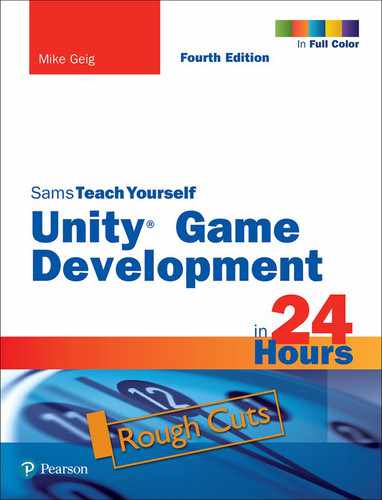In just 24 lessons of one hour or less, Sams Teach Yourself Unity Game Development in 24 Hours will help you master the Unity game engine. This books straightforward, step-by-step approach teaches you everything from the absolute basics through sophisticated game physics, animation, and mobile device deployment techniques. Every lesson builds on what youve already learned, giving you a rock-solid foundation for real-world success. Step-by-step instructions carefully walk you through the most common Unity game development tasks. Practical, hands-on examples show you how to apply what you learn. Quizzes and exercises help you test your knowledge and stretch your skills. Notes and Tips point out shortcuts and solutions. Learn how to Get up and running fast with the Unity game engine and editor Work efficiently with Unitys graphical asset pipeline Make the most of lights and cameras Sculpt stunning worlds with Unitys terrain and environmental tools Script tasks ranging from capturing input to building complex behaviors Quickly create repeatable, reusable game objects with prefabs Implement easy, intuitive game user interfaces Control players through built-in and custom character controllers Build realistic physical and trigger collisions Leverage the full power of Unitys Animation and new Timeline systems Integrate complex audio into your games Use mobile device accelerometers and multi-touch displays Build engaging 2D games with Unitys 2D tools and Tilemap Apply the finishing touches and deploy your games
Table of Contents
- Cover Page
- Title Page
- Copyright Page
- Dedication Page
- Preface
- Acknowledgments
- About the Author
- Contents
- Table of Contents
- Hour 1. Introduction to Unity
- Hour 2. Game Objects
- Hour 3. Models, Materials, and Textures
- Hour 4. Terrain and Environments
- Hour 5. Lights and Cameras
- Hour 6. Game 1: Amazing Racer
- Hour 7. Scripting, Part 1
- Hour 8. Scripting, Part 2
- Hour 9. Collision
- Hour 10. Game 2: Chaos Ball
- Hour 11. Prefabs
- Hour 12. 2D Game Tools
- Hour 13. 2D Tilemaps
- Hour 14. User Interfaces
- Hour 15. Game 3: Captain Blaster
- Hour 16. Particle Systems
- Hour 17. Animations
- Hour 18. Animators
- Hour 19. Timeline
- Hour 20. Game 4: Gauntlet Runner
- Hour 21. Audio
- Hour 22. Mobile Development
- Hour 23. Polish and Deploy
- Hour 24. Wrap-up
